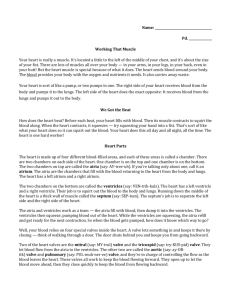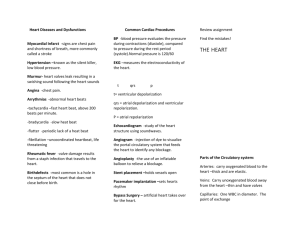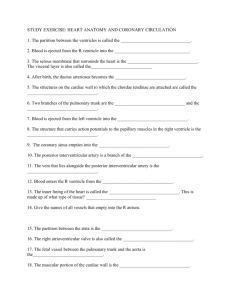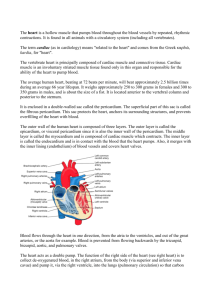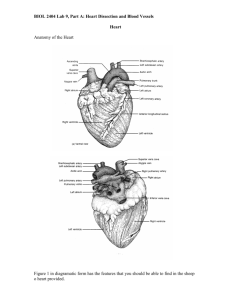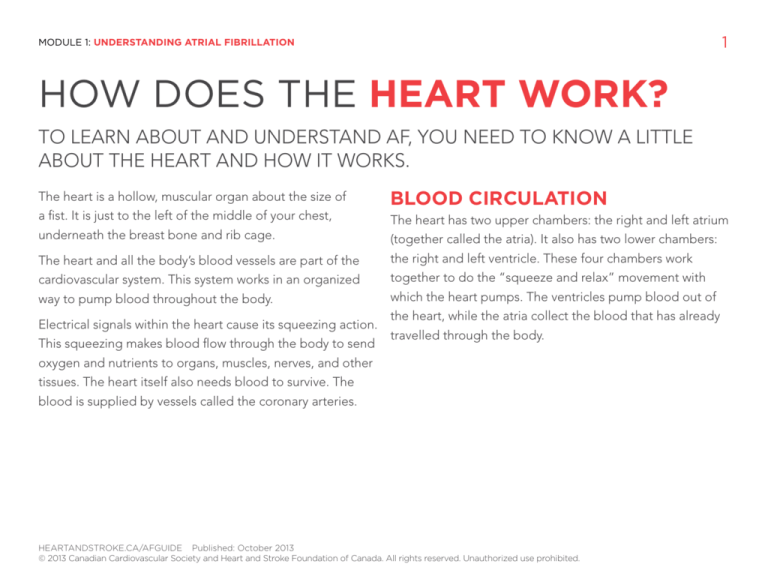
1
MODULE 1: UNDERSTANDING ATRIAL FIBRILLATION
HOW DOES THE HEART WORK?
TO LEARN ABOUT AND UNDERSTAND AF, YOU NEED TO KNOW A LITTLE
ABOUT THE HEART AND HOW IT WORKS.
The heart is a hollow, muscular organ about the size of
a fist. It is just to the left of the middle of your chest,
underneath the breast bone and rib cage.
BLOOD CIRCULATION
The heart has two upper chambers: the right and left atrium
(together called the atria). It also has two lower chambers:
the right and left ventricle. These four chambers work
The heart and all the body’s blood vessels are part of the
together to do the “squeeze and relax” movement with
cardiovascular system. This system works in an organized
which the heart pumps. The ventricles pump blood out of
way to pump blood throughout the body.
the heart, while the atria collect the blood that has already
Electrical signals within the heart cause its squeezing action.
travelled through the body.
This squeezing makes blood flow through the body to send
oxygen and nutrients to organs, muscles, nerves, and other
tissues. The heart itself also needs blood to survive. The
blood is supplied by vessels called the coronary arteries.
HEARTANDSTROKE.CA/AFGUIDE Published: October 2013
© 2013 Canadian Cardiovascular Society and Heart and Stroke Foundation of Canada. All rights reserved. Unauthorized use prohibited.
2
MODULE 1: UNDERSTANDING ATRIAL FIBRILLATION
HOW YOUR BLOOD FLOWS
Here is how your blood flows, starting with the
blood that has returned to the heart.
1. Blood travels from the right atrium, through
the tricuspid valve, and into the right ventricle.
aorta
2. The right ventricle pumps the blood through
the pulmonary valve and into the lungs.
pulmonary artery
pulmonary
3
veins
3. In the lungs, oxygen is added to the blood and
carbon dioxide is removed. The blood then
travels through the pulmonary veins and into
left atrium
6
mitral valve
the left atrium.
4. From the left atrium, the oxygenated blood
passes through the mitral valve and into the
left ventricle.
5. The left ventricle pumps blood through the
aortic valve into the aorta, which is the main
supply route to the rest of the body.
4
aortic valve
right atrium
pulmonary valve
1
5
6
tricuspid valve
2
right ventricle
6. “Used” (unoxygenated) blood returns to the
right atrium of the heart.
This cycle repeats with every heart beat.
HEARTANDSTROKE.CA/AFGUIDE Published: October 2013
© 2013 Canadian Cardiovascular Society and Heart and Stroke Foundation of Canada. All rights reserved. Unauthorized use prohibited.
left ventricle
3
MODULE 1: UNDERSTANDING ATRIAL FIBRILLATION
ELECTRICAL CONDUCTION SYSTEM
The pumping action of the heart creates the heart beat. It is
triggered by electrical impulses, or signals, that travel from
the top to the bottom of the heart. These impulses cause
the heart muscles to contract (squeeze), pushing blood out
of the heart to the rest of the body. The heart then relaxes,
allowing more blood to enter before the next beat.
Electrical impulses normally begin at the sinoatrial
(SA) node, the body’s natural pacemaker. Here is how
electrical conduction works in a healthy heart:
1. The SA node sends a signal through the atria, causing them to
contract and pump blood to the ventricles.
1
SA node
4
AV node
2
Bundle of His
2. The electrical impulse travels down to the atrioventricular (AV)
node, which is between the atria and the ventricles.
3. The AV node slows the signals and then sends them through
conduction pathways called the Bundle of His, bundle
branches, and Purkinje fibers.
3
Purkinje fibers
4
4. Through these pathways, the electrical signals stimulate the
ventricles, causing them to contract and pump the blood out.
The ventricles’ contracting is what makes the heart beat.
HEARTANDSTROKE.CA/AFGUIDE Published: October 2013
© 2013 Canadian Cardiovascular Society and Heart and Stroke Foundation of Canada. All rights reserved. Unauthorized use prohibited.
MODULE 1: UNDERSTANDING ATRIAL FIBRILLATION
HEART RATE
The speed of the heart beat is called the heart rate. The
heart rate is usually measured by counting the pulse rate.
It is measured in beats per minute (bpm). The pattern of
the heart beat is called the rhythm.
In a normal heart rhythm, the sinus node initiates 1 atrial beat
for every 1 ventricular beat (1-to-1 electrical conduction).
This is also called normal sinus rhythm.
Not everyone has the same heart rate. Normally, the resting
heart rate is between 50 and 100 bpm and the rhythm is
regular. At night, the heart beat can slow to below 50 bpm.
With exercise, the heart beat can go higher than 100 bpm.
HEARTANDSTROKE.CA/AFGUIDE Published: October 2013
© 2013 Canadian Cardiovascular Society and Heart and Stroke Foundation of Canada. All rights reserved. Unauthorized use prohibited.
4

